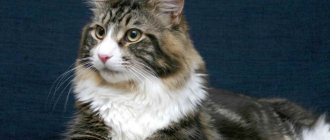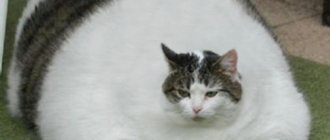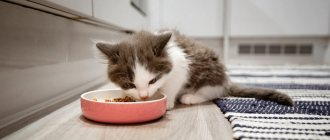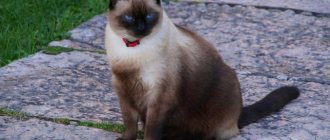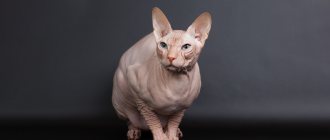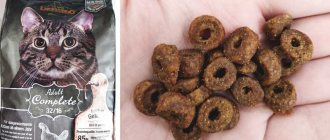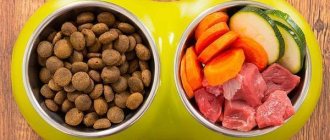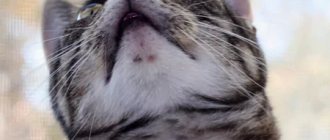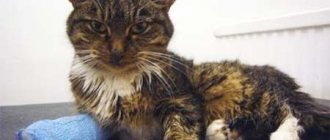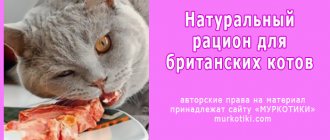How to tell if your cat needs to lose weight
In most cases, obesity develops gradually: if you see your pet every day, you may not notice changes in its appearance or behavior. The main signs indicating the need to lose excess weight include:
- Decreased pet activity. If your cat used to constantly play with a ball or jump on the highest cabinets and shelves, now he prefers to spend most of his time on the sofa or bed. Refusal from active play may be associated with joint pain or the development of shortness of breath, which occurs in an obese animal even with minor exertion.
- External changes. In healthy cats, bony protrusions (ribs, spine) can be easily felt and they have developed dense muscles. With obesity, the animal's waist flattens out, and a hanging belly and fat folds may appear. It is almost impossible to palpate bony landmarks.
- Increased appetite. If you previously fed your furry friend 3-4 times a day, then gradually the number of feedings increases. The animal greedily eats a portion of food and returns for more: there is no satiety due to a distended stomach.
Photo gallery: what obese cats look like
It is more difficult for an overweight cat to move around
Obesity causes sagging of the lower abdomen
Obesity is characterized by a flattened waist or its complete absence
The main factors for gaining excess weight in cats
In most cases, the cause of cat obesity is improper nutrition. The owner overfeeds the pet or adds too much fat and fast carbohydrates to the diet. However, there are other factors that influence excess weight gain:
- sedentary lifestyle: lazy cats are much more prone to obesity;
- castration or sterilization (changes in hormonal levels create the preconditions for gaining excess weight);
- stressful situations (change of residence, appearance of a new pet);
- pregnancy in a cat;
- availability of food in free access;
- abuse of treats;
- consequences of the operation (long-term immobility);
- diseases of the endocrine system requiring medication;
- belonging to some breeds (British cat, Scottish fold, Persian).
Video: veterinarian talks about obesity in animals
How often are control weighings carried out?
After you have developed a plan together with your veterinarian on how to make your cat lose weight, you need to understand its effectiveness. Each animal is individual, so the result is not always obvious.
On average, a veterinarian advises weighing an obese patient at least once a month. This will make it possible to track your weight loss process. If your weight loss is too slow and no more than 500 g per month, then you should reconsider your weight loss program.
How to organize food for overweight cats
When treating obesity in animals, veterinarians are guided by the same principles as nutritionists: the number of calories consumed should be less than their daily expenditure. Such a deficiency creates conditions for burning fatty tissue and allows the pet to quickly get into shape.
To achieve normal body weight, you can use both ready-made food and natural food (at the discretion of the owner).
Basic rules for creating a diet for obese cats:
- Monitor the quality of your food. Use only special food of at least premium class. The economy segment can cause additional health problems in cats. For the same reason, it is recommended to purchase only proven and fresh products when organizing natural nutrition.
- Provide access to clean water. Many cats with a fluid deficiency begin to eat more food to compensate for this deficiency. The water in the bowl should be changed at least twice a day to prevent dust, hair, and food debris from accumulating in it.
- The cat should be fed often, but in small portions. It is better to choose a specific time for this (8, 12, 16, 18, 22, 24 hours). And also stop any begging or food theft by the animal: treats also contain extra calories.
One of my friends’ cat gained a lot of weight over the winter: he gained about 4 extra pounds, which had a negative impact on his health. The owner decided to review his diet and strictly limited his food, and also regularly forced the cat to run after toys. For several months, she tried different types of food, but the furry pet’s weight stubbornly remained the same. The woman was about to seek help from a veterinarian, but one night she caught her husband in the kitchen, together with the cat, finishing a loaf of doctor’s sausage. Such nutrition negated all the daily efforts of the housewife. The husband was given a severe reprimand, and the furry purr was put on a strict diet, after which he still managed to get back into shape.
Organization of dietary meals
Medicinal food to eliminate the problem of excess weight should be given strictly according to the instructions. Thus, such mixtures are contraindicated for cats during the period of active growth and reproduction. Food should be at room temperature, whether dry or wet. You should place a bowl of drinking water near the dishes for dry food for weight loss. You should also take into account the calorie content of different foods:
- Dry, for adults - from 200 to 600 kilocalories per 200 ml.
- Dry, light in nutritional value - from 200 to 400 kilocalories per 200 ml.
- Wet, for adults - from 80 to 200 kilocalories per 185 ml.
- Moist, light in nutrition - from 80 to 200 kilocalories per 185 milliliters.
What ready-made food should you use to reduce your pet’s weight?
For the safe and slow treatment of obesity, a whole line of special veterinary foods has been developed. Unlike regular nutrition, they are aimed at eliminating excess weight and preventing further weight gain. The main advantages of using such feeds include:
- the ability to choose various flavorings;
- no time spent on cooking;
- long-term storage of feed;
- the effectiveness of such nutrition has been proven by veterinarians;
- the presence of the necessary components in the composition and a strict calculation of caloric content (in most cases, additional administration of vitamins and mineral components is not required);
- using a special feeder with timers to dispense a portion of a certain volume.
Mechanism of action and composition of dietary cat food
Medicinal food differs significantly from regular food. It contains much less fat and carbohydrates, which helps reduce the overall calorie intake. The mechanism of action of such food is to ensure longer saturation, stimulation of the gastrointestinal tract and normalization of metabolic processes in the cat’s body. This is achieved due to a certain balance of nutrients. The low-calorie food contains the following components:
- Plant fiber (beet pulp, bran, chopped oats, corn flour, brown rice, spinach). It acts as a natural scrub for the intestines, improving intestinal motility and stimulating timely bowel movements.
- Animal protein (processed beef, fish, poultry). Its amount is several times higher than the level of fats and carbohydrates, which allows you to burn excess fat without losing muscle mass.
- L-carnitine, taurine, mineral complexes and vitamins B, C, A, E. These components accelerate metabolic processes and restore the body’s need for various macro and microelements.
Is it possible to use diet food without consulting a specialist?
You should only select specialized food yourself if you have the appropriate education. When selecting a diet for obese cats, the doctor must take into account the breed of the animal, its weight, and the individual characteristics of the body. This allows you to determine the required calorie content, calculate the number of feedings and the volume of one serving. Before prescribing certain foods, blood tests should be taken to identify possible damage to the liver and digestive tract.
Contraindications to the prescription of dietary nutrition are pregnancy, lactation and age under one year.
How long should you feed your cat medicated food?
In order not to harm your pet’s health, it is necessary to reduce its body weight gradually (no more than 0.5–1% per week). On average, low-calorie food is prescribed for a period of 6 months to a year, after which the cat’s condition is monitored. In some cases (old age, upcoming surgery, certain breeds), the animal must adhere to such a diet throughout its life. This provides reliable prevention of further progression of obesity and increases life expectancy by several years.
It is also worth transitioning your cat to regular food gradually. One of my colleagues had a Persian cat who ate only dietary food for a year, which quenched his appetite and helped him stay in shape. The owner decided that the result had been achieved: the pet could be switched to its usual diet, after which it began to buy regular economy-class food. This diet is characterized by insufficient balance and a minimal amount of fiber. As a result, due to a lack of nutrients, the cat began to regularly steal food from the table, which caused stomach illness. The owners turned to the veterinarian, who selected the best food for them in terms of price and composition.
Is it possible to mix diet food with regular food?
Veterinarians do not recommend combining two foods with each other, since they have completely different energy values and composition. This leads to a significant decrease in the effect of dietary nutrition and the process of treating obesity slows down. But for many cats, a sudden change in diet can become very stressful: in this case, it is permissible to combine two foods with each other. Veterinarians recommend switching the animal to a new food within a week, gradually replacing the old one.
Changing food will be painless if the new food is introduced gradually
First, visit the veterinarian
Contacting a specialist is an important point in the desire to help your pet. Owners do not always understand what the optimal body weight of their pet should be. For example, the constitution of the Persian representatives is very different from the lean Siamese. It would seem that everything is very simple - you need to feed the animal less, and the weight will decrease.
Unfortunately, not everything is so obvious. You should not put your cat on a diet without first consulting a specialist. Even a two-day hunger can be dangerous for an animal. It leads to irreversible damage to the liver and kidneys.
To begin with, the mustachioed fatty must be examined by a veterinarian. If necessary, he prescribes additional laboratory tests of the patient’s blood or urine. Tests can help identify hidden diseases or other problems that are preventing you from losing fat. Sometimes an animal’s illness or its advanced age become serious contraindications for prescribing a diet.
Table: comparative characteristics of dietary feeds of various brands
| Name of food | Class | View | Flavors | Peculiarities | Price |
| Eukanuba Adult Sterilized Weight Control Chicken | Superpremium | Dry | Chicken | Designed for sterilized and neutered male cats |
|
| Hill's Prescription Diet Metabolic Weight Management | Superpremium | Dry | Chicken | Allows you to maintain optimal weight |
|
| Hill's Prescription Diet Metabolic + Urinary Weight Care | Superpremium | Dry | Chicken, turkey | Also used for cats with urinary tract diseases |
|
| Hill's Prescription Diet i/d Digestive Care (jelly) | Superpremium | Wet | Chicken | Helps maintain a healthy digestive tract |
|
| Hill's Prescription Diet w/d Digestive/Weight Management | Superpremium | Dry | Chicken | Helps normalize weight in diabetic cats |
|
| Hill's Prescription Diet w/d Digestive/Weight Management (jelly) | Superpremium | Wet | Chicken | Better absorbed by the pet's stomach |
|
| Royal Canin Satiety Weight Management SAT34 | Superpremium | Dry | Chicken, poultry | Can be used for diabetes and urolithiasis |
|
| Royal Canin Neutered Adult Maintenance | Superpremium | Wet | Chicken, pork, poultry, liver | Suitable for sterilized animals in the postoperative period |
|
| Pro Plan Veterinary Diets Feline OM Obesity (Overweight) Management dry | Premium | Dry | Chicken, poultry | Used for adult cats |
|
| Farmina Vet Life Natural Diet Cat Obesity | Premium | Dry | Chicken, pork, poultry | Prevents muscle loss | 2 kg - 1709 rub. |
| Royal Canin Satiety Weight Management (jelly) | Superpremium | Wet | Chicken | Suitable for pets with diabetes |
|
| Purina Pro Plan Veterinary Diets OM pouches | Superpremium | Wet | Chicken | Helps maintain weight |
|
| Happy Cat Adipositas | Superpremium | Dry | Chicken, poultry | Also used for cats with liver disease |
|
| Brit VDC Obesity | Superpremium | Dry | Chicken | Suitable for British cats, grain free | 2 kg - 1240 rub. |
| Forza10 Active Line | Superpremium | Dry | Fish | Consists of heart-shaped granules | 454 g - 470 rub. |
| Enova Breeder Cat Light Indoor | Superpremium | Dry | Chicken, rice | Can be used to feed cats over 7 years of age | 10 kg - 6300 rub. |
| Bosch Sanabelle Light for cats prone to obesity | Superpremium | Dry | Bird | Provides quick satiety due to the large amount of dietary fiber | 2 kg - 1300 rub. |
| Barking Heads Adult Fat Cat Slim | Holistic | Dry | Chicken, salmon | Suitable for pets with sensitive stomachs |
|
| 1st Choice Weight Control | Superpremium | Dry | Chicken | Designed for adult animals | 5.5 kg - 2600 rub. |
Photo gallery: examples of dietary foods
Hill's Prescription Diet i/d Digestive Care stimulates the stomach and intestines Purina Pro Plan Veterinary Diets OM pouches improves digestion Royal Canin Satiety Weight Management comes in jelly form Forza10 Active Line has an original heart-shaped granule shape Happy Cat Adipositas helps reduce weight in cats with disease liver Hill's Prescription Diet w/d Digestive/Weight Management is used for cats with diabetes Hill's Prescription Diet Metabolic Weight Management helps maintain proper body weight Pro Plan Veterinary Diets Feline OM Obesity allows you to quickly lose excess weight
Kidney disease - diet
Only an experienced nutritionist can choose the right menu to cure kidney disease in cats. The amount of nutrients is calculated as a percentage and depends on the stage of the disease, the overall condition of the pet and its level of activity. Diet during this disease helps reduce the intake of proteins, phosphorus, sodium, potassium and bicarbonates. It is also necessary to significantly reduce the amount of food, and so that it is not high in calories.
“It is necessary to control the moisture in food every time the owner feeds his cat.”
At some stages it is necessary to give a lot of water, while at others, on the contrary, it is necessary to significantly reduce it. This is necessary in order to prevent the pet from developing edema. Almost always, during the diet for kidney failure, ready-made medicinal feeds are given. It is not always possible to calculate the proportions of good and bad elements in real products at home. Therefore, only a specialist can cope with the task.
Feeding Obese Cats Natural Products
If your animal has gained excess weight on a natural diet, you should also reconsider its diet. Don't forget that a healthy adult cat's diet should include proteins and fats of animal origin. You shouldn’t suddenly switch your furry pet to plant foods or greatly reduce portion sizes: this will only provoke unnecessary stress. Veterinarians recommend using the following products to feed overweight cats:
- Meat, offal and fish contain the required amount of protein and essential amino acids. Lean beef, rabbit, chicken or turkey are suitable for dietary nutrition. Of the by-products, preference should be given to hearts and liver. Meat should be served boiled or fresh frozen to destroy helminths. For dietary nutrition, steamed sea fish (trout, salmon) is mainly used.
- Milk based products. Kefir, cottage cheese, fermented baked milk, goat cheese, bifidok are sources of calcium and easily digestible protein, so they must be included in the cat’s diet. Please note that their fat content should not exceed 2–5%.
- Porridge and cereals. The fiber they contain provides satiety and acts as a natural scrub for the intestines, removing toxins. Cereals that are healthy for cats include rolled oats, brown rice, and millet. They need to be boiled in water or chicken broth.
- Greens and vegetables. They are used as an additive to cereals or meat: they should be boiled and ground in a blender. The best foods for feeding cats are spinach, celery, zucchini, squash, green beans, carrots, broccoli, and cauliflower.
Photo gallery: healthy foods for pets
By-products contain the required amount of protein
Dairy products are rich in calcium
Vegetables are the best source of vitamins and minerals
It is harmful to feed cats from the home table: our food contains a large amount of salt and various additives that negatively affect their health. Such a diet contributes to the development of obesity and other dangerous diseases. Veterinarians strictly prohibit giving overweight cats the following foods:
- sausage, frankfurters, small sausages;
- semi-finished products (cutlets, zrazy, dumplings);
- butter;
- chicken skin and fat from meat;
- bones;
- processed cheese;
- ice cream;
- sweet yoghurts and curds.
Medicinal feed
Veterinarians strongly recommend ready-made diets, due to the fact that it is difficult to follow all the rules of feeding your pet the right foods.
For example, you can put your pet on a protein-free diet. The owner needs to remove protein from animal sources from the diet; cats really need this product. The diet is needed to heal your pet’s kidneys and liver. Also, at the same time, the owner introduces a diet and adds special drops to the food.
There is another option: start buying your pet special premium canned food that contains little protein and calories. They help overcome the disease, provide a diuretic effect and remove bad toxins. Among the foods that have a high rating are the following:
- Proplan is a food, an exact copy of the original purina veterinary diet food for domestic cats.
- Hills.
- Kanin – 1 packet is enough to restore stomach function.
Owners often think about how to properly keep their pet on a diet so that it eats simple and light cereals, without adding meat. How to make a varied menu from a small number of products, there is a way out. There is dry food that has medicinal effects. It can be fed to both sick cats and those that are recovering. But you can give high-quality dietary food for domestic cats to animals after consultation with a veterinarian.
Also, cat owners should know that it is not always possible to use industrial diets; for some diseases, it is necessary to give the pet natural foods to eat. Elderly cats are not allowed to eat food; traditional food is suitable for them.
Essential vitamins and mineral complexes
When organizing natural nutrition, it is quite difficult to take into account the cats’ need for vitamins and minerals when preparing a diet. Often, in their absence, metabolic processes slow down and various diseases can develop. To avoid such complications, you need to contact your veterinarian to select the optimal complex of vitamins and mineral components. They usually come in the form of pleasant-smelling tablets that can be crushed finely and added to your cat's food.
Give preference to proven products from a veterinary pharmacy. For example, adding crushed shells to an animal’s diet is not welcomed by veterinarians, as it can lead to digestive disorders.
The most popular vitamins and mineral complexes for cats:
- Beaphar Top 10 (contains taurine);
- Canina Cat-Vitamin Tabs;
- VetExpert VetAminex;
- Doctor Zoo "Health and Beauty";
- Dreamies pillows with chicken and taurine;
- Phytomines for castrated cats;
- Gimpet Schnurries (to normalize metabolism);
- Nutri-Vet Wild Alaskan Salmon Oil.
Please note that vitamins should be stored out of the reach of cats. Once, on the advice of a veterinarian, I bought vitamins for my cat, which he liked. I accidentally left the box on the table, which my pet took advantage of. He ate about half of the tablets, which did not affect his health in any way, but led to a complete aversion to them. The cat completely refused vitamins for several months.
Photo gallery: vitamins and mineral complexes
Canina Cat-Vitamin Tabs - multivitamin complex
Doctor Zoo is a domestic brand
Phytomines are used for castrated cats
Urolithiasis - diet
It is possible to determine that an animal has urolithiasis after examining its urine. It is also important to understand what type of disease, because the diet depends on this.
- Struvite - for this purpose, urine is oxidized, so they stop feeding food with calcium. Prohibited foods include yolk, milk, cottage cheese and hard cheese. The menu may consist of lean, but boiled lamb, veal or rabbit. River fish in small quantities is also suitable. Boiled chicken liver, oatmeal or rice, in small quantities. Carrots, cauliflower and zucchini.
- Oxalates – remove foods that contain salts, acids and reduce the flow of calcium into the stomach. It is forbidden to eat liver, kidneys, many vegetables, green vegetables and fruits. The menu consists of boiled lean meat, boiled lean fish, in small quantities. Porridges cooked in water, oatmeal and rice. Cabbage, beets, legumes and carrots.
At some points, during urolithiasis, it is forbidden to eat fish. Therefore, if you have questions, you need to ask your veterinarian for advice and find out what the menu should be.
Diet for pancreatitis
The disease pancreatitis in cats increases carbohydrates and fats, so the diet should help reduce them. The diet will help increase good protein in the body. The cat should only be given foods that are quickly digestible. The diet consists of 3–5 feedings a day in small portions. The food temperature should be slightly above room temperature . The products are ground, cut into small slices, and prepared into purees and soufflés.
Food in the form of broths, all types of soups, meat, fish, vegetables, herbs and fruits are not given. If the disease has worsened, the pet is not fed at all for some time, and fasting days are carried out for 1-2 days.
The food composition of the menu includes the following products:
- Chicken soups, always with 2-3 broth.
- Not fatty veal, chicken, lamb, rabbit.
- Not oily fish, boiled or steamed.
- Carrot puree, zucchini, beet, pumpkin.
- Chop.
- Milk, cottage cheese and eggs.
- Vegetable oil.
Diet while overweight
Extra pounds can cause diabetes. To maintain weight and get your pet to lose weight, it needs to be fed properly. Not all cats are overweight. If a person thinks that his pet is fat, he needs to be put on a diet. For such cases, there are dietary cat foods. But before putting a cat on the right diet, ask a veterinarian for advice.
Losing weight takes a long time, and unforeseen complications can occur. In many cases, a vegetarian diet is used, and the pet’s characteristics are also observed. There are several conditions and tips that will help you create a menu for losing weight for a cat:
- To reduce daily calories, you can reduce the number of servings or the number of feedings per day. It is advisable to create a menu with the help of an experienced animal nutritionist.
- The cat needs to be given more water, because water has properties that help quickly saturate the body.
- Increasing low-calorie supplements, which also help saturate the pet's body. For example, use the fortiflor nutritional supplement. Cat food can be eaten by kittens and adult cats; the drug does not cause diarrhea and has a beneficial effect on the intestines.
- If your veterinarian allows it, you can increase your cat's physical activity and play with her more.
- The amount of food must be carefully monitored and measured to ensure that the food is not overloaded with calories.
- If the owner keeps more than one cat in the house, then they should be fed separately. So that the pet who is on a diet cannot get a large excess of food, because he will not only gain extra pounds, but may also vomit.
- Do not give animals treats that contain fat. Only low-calorie treats should be given, such as corn, beans or carrots.
- In order to avoid frequent visits to the doctor, you can weigh your pet yourself.
- Food should not cause allergies in cats, as this will lead to severe poisoning. Therefore, be sure to consult a veterinarian before starting a diet.
To improve your pet's weight, you need to keep it on a diet for 8-12 months. The maximum amount of weight loss per day is 125-250 grams.
Following a diet menu will be difficult for both the owner and his pet. If the owner wants his cat to be healthy, he needs to give attention and care to the pet.
Diet for sterile cats
When a cat is spayed or neutered, this can lead to a slower metabolism and decreased activity. If the animal is quiet after surgery and eats normally, the cat may recover. Usually, castration of a cat begins at six months, so the owner must control the diet to prevent obesity.
Those cats that have not yet gained weight should eat healthy food in moderate quantities. Food should not be greasy and warm. Feeding is carried out once a day. To prevent a neutered pet from developing diarrhea or constipation, he is not given highly salty foods, smoked foods, sausages, sour cream, cottage cheese, potatoes and flour. The diet for clean cats prohibits the consumption of the same foods, and the portion is reduced by 15-25%.
Inactive animals may develop polycystic disease. To reduce the risk of this disease, the diet should be balanced. Many experts advise feeding purina food - this is a super diet for cats. Purina not only allows the stomach to function properly, but also gives the animals a beautiful appearance.
Why do pets get fat?
1. Unbalanced feeding
A common cause of obesity in a pet is improper feeding.
Mistakes the owner makes when planning his pet’s diet:
- Overfeeding;
- High calorie diet;
- Mixed type of feeding;
- Harmful treats in the diet;
- Encouraging begging.
2. Passive lifestyle
Many cats constantly stay at home, their activity is limited by the area of the apartment. A pet's sedentary lifestyle and unbalanced feeding lead to weight gain in the pet.
3. Metabolic disorders
Obesity occurs in diseases associated with metabolic disorders. Obesity is often associated with hormonal changes. With a lack of hormones from the pituitary gland, adrenal glands, thyroid and pancreas, fat metabolism is disrupted, which leads to excessive fat deposition in the organs and tissues of the pet.
4. Breed predisposition
Some cat breeds are predisposed to obesity. If you are the owner of a Scottish, Himalayan, British, or Persian cat, pay special attention to the calorie intake and mobility of your pet.
5. Age
Older cats are more prone to obesity than younger cats. With age, animals, like humans, slow down their metabolism and decrease their activity. Excess calories are stored as fat on the sides and stomach.
6. Castration
The energy requirement of castrated animals is significantly reduced. If you continue to feed your cat after castration the same food and in the same quantity, this will lead to weight gain and obesity. After surgery, use a low-calorie, low-fat diet.
